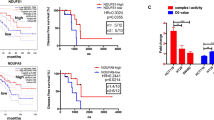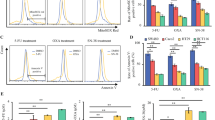Abstract
Mitochondrial respiration and metabolism play an important role in the occurrence and development of colorectal cancer (CRC). In this study, we identified a functional pool of SLIT–ROBO Rho GTPase-activating protein 2 (SRGAP2) in the mitochondria of CRC cells as an important regulator of CRC chemosensitivity. We found that SRGAP2 levels were increased in CRC cells in comparison to normal colorectal cells. Loss of mitochondrial SRGAP2 led to significant decrease in mitochondrial respiration and strongly sensitized the CRC cells to chemotherapy drugs. Mechanistically, SRGAP2 physically interacts with mitochondrial complex I and positively modulates its activity. In particular, chemosensitization upon SRGAP2 loss was phenocopied by the treatment of complex I inhibitor. Thus, our results demonstrate that SRGAP2 functions as a key regulator of CRC chemosensitivity, identifying SRGAP2 as a promising therapeutic target to enhance the efficacy of chemotherapy in CRC.






Similar content being viewed by others
Data Availability Statement
CRC transcriptome sequencing data and corresponding clinical data set were downloaded from TCGA (https://cancergenome.nih.gov, TCGA–COAD and TCGA–READ).
Abbreviations
- CRC:
-
Colorectal cancer
- TCGA:
-
The Cancer Genome Atlas
- OCR:
-
Oxygen consumption rate
- MTS:
-
Mitochondrial targeting signal
- NLS:
-
Nuclear localization sequence
- SRB:
-
Sulforhodamine B
- 5-FU:
-
5-Flourouracil
- 3’ UTR:
-
3′ Untranslated region
- EV:
-
Empty vector
References
Siegel RL, Miller KD, Fuchs HE, Jemal A. Cancer statistics, 2022. CA Cancer J Clin. 2022;72:7–33. https://doi.org/10.3322/caac.21708.
Hammond WA, Swaika A, Mody K. Pharmacologic resistance in colorectal cancer: a review. Ther Adv Med Oncol. 2016;8:57–84. https://doi.org/10.1177/1758834015614530.
Heiden MGV, Cantley LC, Thompson CB. Understanding the warburg effect: the metabolic requirements of cell proliferation. Science. 2009;324:1029–33. https://doi.org/10.1126/science.1160809.
Chekulayev V, et al. Metabolic remodeling in human colorectal cancer and surrounding tissues: alterations in regulation of mitochondrial respiration and metabolic fluxes. Biochem Biophys Rep. 2015;4:111–25. https://doi.org/10.1016/j.bbrep.2015.08.020.
Kaldma A, et al. An in situ study of bioenergetic properties of human colorectal cancer: the regulation of mitochondrial respiration and distribution of flux control among the components of ATP synthasome. Int J Biochem Cell Biol. 2014;55:171–86. https://doi.org/10.1016/j.biocel.2014.09.004.
Boyle KA, et al. Mitochondria-targeted drugs stimulate mitophagy and abrogate colon cancer cell proliferation. J Biol Chem. 2018;293:14891–904. https://doi.org/10.1074/jbc.RA117.001469.
Lin CS, et al. Role of mitochondrial function in the invasiveness of human colon cancer cells. Oncol Rep. 2018;39:316–30. https://doi.org/10.3892/or.2017.6087.
Wen YA, et al. The mitochondrial retrograde signaling regulates Wnt signaling to promote tumorigenesis in colon cancer. Cell Death Differ. 2019;26:1955–69. https://doi.org/10.1038/s41418-018-0265-6.
Bosc C, Selak MA, Sarry JE. Resistance is futile: targeting mitochondrial energetics and metabolism to overcome drug resistance in cancer treatment. Cell Metab. 2017;26:705–7. https://doi.org/10.1016/j.cmet.2017.10.013.
Denise C, et al. 5-fluorouracil resistant colon cancer cells are addicted to OXPHOS to survive and enhance stem-like traits. Oncotarget. 2015;6:41706–21. https://doi.org/10.18632/oncotarget.5991.
Vellinga TT, et al. SIRT1/PGC1alpha-dependent increase in oxidative phosphorylation supports chemotherapy resistance of colon cancer. Clin Cancer Res. 2015;21:2870–9. https://doi.org/10.1158/1078-0432.CCR-14-2290.
Guerrier S, et al. The F-BAR domain of srGAP2 induces membrane protrusions required for neuronal migration and morphogenesis. Cell. 2009;138:990–1004. https://doi.org/10.1016/j.cell.2009.06.047.
Guo SS, Bao SL. srGAP2 arginine methylation regulates cell migration and cell spreading through promoting dimerization. J Biol Chem. 2010;285:35133–41. https://doi.org/10.1074/jbc.M110.153429.
Li Y, et al. Identification of SRGAP2 as a potential oncogene and a prognostic biomarker in hepatocellular carcinoma. Life Sci. 2021;277:119592. https://doi.org/10.1016/j.lfs.2021.119592.
Marko TA, et al. Slit-Robo GTPase-Activating Protein 2 as a metastasis suppressor in osteosarcoma. Sci Rep. 2016;6:39059. https://doi.org/10.1038/srep39059.
Chatterjee A, et al. MOF Acetyl Transferase Regulates Transcription and Respiration in Mitochondria. Cell. 2016;167:722–38. https://doi.org/10.1016/j.cell.2016.09.052.
Chiu HY, et al. Nanoparticle mediated delivery and small molecule triggered activation of proteins in the nucleus. Nucleus. 2018;9:530–42. https://doi.org/10.1080/19491034.2018.1523665.
Dang CV, Lee WM. Identification of the human c-myc protein nuclear translocation signal. Mol Cell Biol. 1988;8:4048–54. https://doi.org/10.1128/mcb.8.10.4048-4054.1988.
Jia YH, et al. Lamin B1 loss promotes lung cancer development and metastasis by epigenetic derepression of RET. J Exp Med. 2019;216:1377–95. https://doi.org/10.1084/jem.20181394.
Liang XJ, et al. SIRT1 contributes in part to cisplatin resistance in cancer cells by altering mitochondrial metabolism. Mol Cancer Res. 2008;6:1499–506. https://doi.org/10.1158/1541-7786.MCR-07-2130.
Yun CW, Han YS, Lee SH. PGC-1alpha controls mitochondrial biogenesis in drug-resistant colorectal cancer cells by regulating endoplasmic reticulum stress. Int J Mol Sci. 2019. https://doi.org/10.3390/ijms20071707.
Divakaruni AS, Rogers GW, Murphy AN. Measuring mitochondrial function in permeabilized cells using the seahorse XF analyzer or a clark-type oxygen electrode. Curr Protoc Toxicol. 2014;60:25.22-21.16. https://doi.org/10.1002/0471140856.tx2502s60.
Murai M, Miyoshi H. Current topics on inhibitors of respiratory complex I. Biochim Biophys Acta. 1857;884–891:2016. https://doi.org/10.1016/j.bbabio.2015.11.009.
Heinz S, et al. Mechanistic investigations of the mitochondrial complex I inhibitor rotenone in the context of pharmacological and safety evaluation. Sci Rep. 2017;7:45465. https://doi.org/10.1038/srep45465.
Jiao Q, et al. Dynamic expression of srGAP2 in cell nuclei and cytoplasm during the differentiation of rat neural stem cells in vitro. Mol Med Rep. 2016;14:4599–605. https://doi.org/10.3892/mmr.2016.5795.
Masoud R, et al. Targeting mitochondrial complex I overcomes chemoresistance in high OXPHOS pancreatic cancer. Cell Rep Med. 2020;1: 100143. https://doi.org/10.1016/j.xcrm.2020.100143.
Yoshida J, et al. Mitochondrial complex I inhibitors suppress tumor growth through concomitant acidification of the intra- and extracellular environment. iScience. 2021;24:103497. https://doi.org/10.1016/j.isci.2021.103497.
Pfanner N, Warscheid B, Wiedemann N. Mitochondrial proteins: from biogenesis to functional networks. Nat Rev Mol Cell Biol. 2019;20:267–84. https://doi.org/10.1038/s41580-018-0092-0.
Claros MG, Vincens P. Computational method to predict mitochondrially imported proteins and their targeting sequences. Eur J Biochem. 1996;241:779–86. https://doi.org/10.1111/j.1432-1033.1996.00779.x.
Fukasawa Y, et al. MitoFates: improved prediction of mitochondrial targeting sequences and their cleavage sites. Mol Cell Proteomics. 2015;14:1113–26. https://doi.org/10.1074/mcp.M114.043083.
Lee J, et al. Mitochondrial cyclic AMP response element-binding protein (CREB) mediates mitochondrial gene expression and neuronal survival. J Biol Chem. 2005;280:40398–401. https://doi.org/10.1074/jbc.C500140200.
Li M, et al. Identification and characterization of mitochondrial targeting sequence of human apurinic/apyrimidinic endonuclease 1. J Biol Chem. 2010;285:14871–81. https://doi.org/10.1074/jbc.M109.069591.
Marchenko ND, Zaika A, Moll UM. Death signal-induced localization of p53 protein to mitochondria. A potential role in apoptotic signaling. J Biol Chem. 2000;275:16202–12. https://doi.org/10.1074/jbc.275.21.16202.
Wiedemann N, Pfanner N. Mitochondrial machineries for protein import and assembly. Annu Rev Biochem. 2017;86:685–714. https://doi.org/10.1146/annurev-biochem-060815-014352.
Acknowledgements
We thank the TCGA Research Network for providing its platforms and valuable data sets.
Funding
This present study was funded by Key Research and Development Project of Chuzhou (Grant no. 2020ZN007).
Author information
Authors and Affiliations
Contributions
TY, LG, JY, and ST were responsible for the concept and design of the original study. TY and LG performed the experiments and analysed data. JY and ST wrote the paper with input from all authors. All authors contributed to the article and approved the submitted version.
Corresponding authors
Ethics declarations
Conflicts of Interest
The authors declare no conflict of interest.
Ethics approval
Not applicable.
Informed consent
Not applicable.
Additional information
Publisher's Note
Springer Nature remains neutral with regard to jurisdictional claims in published maps and institutional affiliations.
Supplementary Information
Below is the link to the electronic supplementary material.





Rights and permissions
Springer Nature or its licensor holds exclusive rights to this article under a publishing agreement with the author(s) or other rightsholder(s); author self-archiving of the accepted manuscript version of this article is solely governed by the terms of such publishing agreement and applicable law.
About this article
Cite this article
Tang, Y., Liu, G., Jia, Y. et al. SRGAP2 controls colorectal cancer chemosensitivity via regulation of mitochondrial complex I activity. Human Cell 35, 1928–1938 (2022). https://doi.org/10.1007/s13577-022-00781-7
Received:
Accepted:
Published:
Issue Date:
DOI: https://doi.org/10.1007/s13577-022-00781-7




